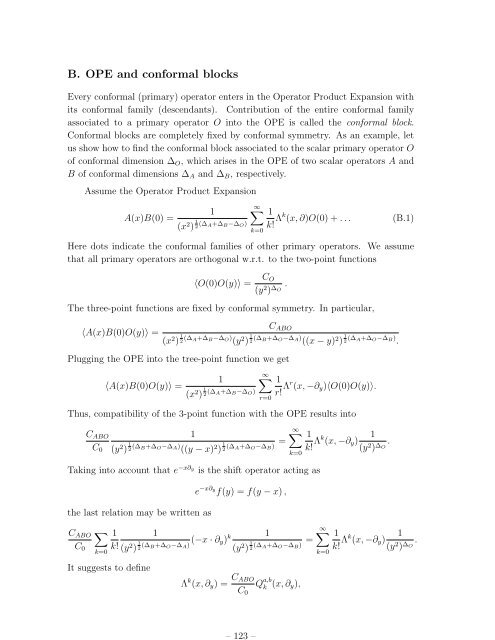Lectures on String Theory
Lectures on String Theory
Lectures on String Theory
You also want an ePaper? Increase the reach of your titles
YUMPU automatically turns print PDFs into web optimized ePapers that Google loves.
– 123 –<br />
B. OPE and c<strong>on</strong>formal blocks<br />
Every c<strong>on</strong>formal (primary) operator enters in the Operator Product Expansi<strong>on</strong> with<br />
its c<strong>on</strong>formal family (descendants). C<strong>on</strong>tributi<strong>on</strong> of the entire c<strong>on</strong>formal family<br />
associated to a primary operator O into the OPE is called the c<strong>on</strong>formal block.<br />
C<strong>on</strong>formal blocks are completely fixed by c<strong>on</strong>formal symmetry. As an example, let<br />
us show how to find the c<strong>on</strong>formal block associated to the scalar primary operator O<br />
of c<strong>on</strong>formal dimensi<strong>on</strong> ∆ O , which arises in the OPE of two scalar operators A and<br />
B of c<strong>on</strong>formal dimensi<strong>on</strong>s ∆ A and ∆ B , respectively.<br />
Assume the Operator Product Expansi<strong>on</strong><br />
A(x)B(0) =<br />
1<br />
(x 2 ) 1 2 (∆ A+∆ B −∆ O )<br />
∞∑<br />
k=0<br />
1<br />
k! Λk (x, ∂)O(0) + . . . (B.1)<br />
Here dots indicate the c<strong>on</strong>formal families of other primary operators. We assume<br />
that all primary operators are orthog<strong>on</strong>al w.r.t. to the two-point functi<strong>on</strong>s<br />
〈O(0)O(y)〉 =<br />
C O<br />
.<br />
(y 2 ) ∆ O<br />
The three-point functi<strong>on</strong>s are fixed by c<strong>on</strong>formal symmetry. In particular,<br />
〈A(x)B(0)O(y)〉 =<br />
C ABO<br />
(x 2 ) 1 2 (∆ A+∆ B −∆ O ) (y 2 ) 1 2 (∆ B+∆ O −∆ A ) ((x − y) 2 ) 1 2 (∆ A+∆ O −∆ B ) .<br />
Plugging the OPE into the tree-point functi<strong>on</strong> we get<br />
〈A(x)B(0)O(y)〉 =<br />
1<br />
(x 2 ) 1 2 (∆ A+∆ B −∆ O )<br />
∞∑<br />
r=0<br />
1<br />
r! Λr (x, −∂ y )〈O(0)O(y)〉.<br />
Thus, compatibility of the 3-point functi<strong>on</strong> with the OPE results into<br />
C ABO<br />
C 0<br />
1<br />
(y 2 ) 1 2 (∆ B+∆ O −∆ A ) ((y − x) 2 ) 1 2 (∆ A+∆ O −∆ B ) = ∞<br />
∑<br />
k=0<br />
1<br />
1<br />
k! Λk (x, −∂ y ) .<br />
(y 2 ) ∆ O<br />
Taking into account that e −x∂ y<br />
is the shift operator acting as<br />
the last relati<strong>on</strong> may be written as<br />
C ABO<br />
C 0<br />
k=0<br />
e −x∂ y<br />
f(y) = f(y − x) ,<br />
∑ 1 1<br />
k! (y 2 ) (−x · ∂ 1 2 (∆ B+∆ O −∆ A<br />
y) k 1<br />
)<br />
(y 2 ) = ∑ ∞<br />
1<br />
1<br />
1<br />
2 (∆ A+∆ O −∆ B ) k! Λk (x, −∂ y ) .<br />
(y 2 ) ∆ O<br />
It suggests to define<br />
Λ k (x, ∂ y ) = C ABO<br />
C 0<br />
Q a,b<br />
k<br />
(x, ∂ y),<br />
k=0

















